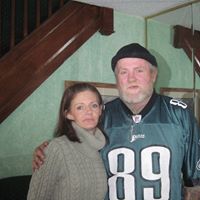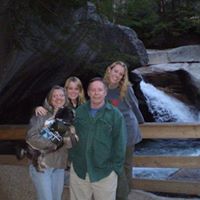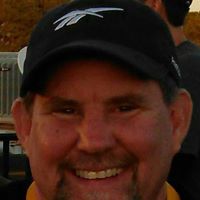Michael J Garrity
age ~50
from Oakwood, OH
- Also known as:
-
- Michael Joseph Garrity
- Kelley R Garrity
- Mike J Garrity
- Phone and address:
-
50 Rubicon Rd, Dayton, OH 45409
6035523670
Michael Garrity Phones & Addresses
- 50 Rubicon Rd, Dayton, OH 45409 • 6035523670
- Oakwood, OH
- Windber, PA
- Bozeman, MT
- 43 Mammoth Rd, Londonderry, NH 03053
- Seneca, SC
- Boone, NC
- Madison, NC
- Central, SC
Work
-
Company:Bp americaSep 2012
-
Position:(independent contractor), principal client
Education
-
School / High School:Emerson College- Boston, MAAug 1998
-
Specialities:Bachelor of Science in Broadcast Journalism
Ranks
-
Licence:Montana - Active
-
Date:1977
Us Patents
-
Update Traversal Of Object Trees For Multiprocessor Systems
view source -
US Patent:8130239, Mar 6, 2012
-
Filed:Mar 31, 2008
-
Appl. No.:12/059312
-
Inventors:Michael Patrick Garrity - Lexington MA, US
-
Assignee:The Mathworks, Inc. - Natick MA
-
International Classification:G06F 13/00
G09G 5/36
G06F 1/00
G09G 5/00 -
US Classification:345619, 345553, 345537, 345522
-
Abstract:A system stores a first object tree that describes a graphical scene in memory and creates a second object tree based on the first object tree, where the second object tree is optimized for use by a graphics processing unit (GPU) to render a graphical scene. The system receives indications of one or more changes associated with the first object tree and traverses the first object tree to make the one or more changes to the first object tree and to generate a composite command for use in making corresponding changes in the second object tree. The system executes the composite command to make the corresponding changes in the second object tree.
-
Parallel Processing Of Object Subtrees For Multiprocessor Systems
view source -
US Patent:8294704, Oct 23, 2012
-
Filed:Apr 14, 2008
-
Appl. No.:12/102193
-
Inventors:Michael Patrick Garrity - Lexington MA, US
-
Assignee:The MathWorks, Inc. - Natick MA
-
International Classification:G06F 17/00
-
US Classification:345418, 345505
-
Abstract:A method implemented by one or more computers may include receiving data for graphical rendering and distributing a first portion of the data to a first computation process. The method may further include distributing a second portion of the data to a second computation process, where the second computation process is different than the first computation process, creating a first object subtree via the first computation process based on the first portion of the data, and creating a second object subtree via the second computation process based on the second portion of the data. The method may further also include assembling an object tree via a third computation process based on the first object subtree and the second object subtree and rendering a graphical scene based on the assembled object tree.
-
Object Transformation For Object Trees Utilized With Multiprocessor Systems
view source -
US Patent:8300060, Oct 30, 2012
-
Filed:Mar 31, 2008
-
Appl. No.:12/059319
-
Inventors:Michael Patrick Garrity - Lexington MA, US
Mario S. Guimaraes - Newton MA, US -
Assignee:The MathWorks, Inc. - Natick MA
-
International Classification:G06T 17/00
G09G 5/02
G09G 5/00 -
US Classification:345589, 345420, 345680
-
Abstract:A system creates a first set of objects in a first structure that describe a graphical scene. A second set of objects is created in a second structure based on the first set of objects in the first structure. The system also performs one or more of the following: i) converting coordinate values in a first coordinate system to coordinate values in a second coordinate system, ii) converting color values in a first color space to color values in a second color space, and/or iii) converting data having first data types or formats to data having second data types or formats, where the first data types or formats are different than the second data types or formats. The system further associates the converted coordinate values, color values and/or data types or formats with the second set of objects and enables a graphical processing unit to use the second set of objects for rendering the graphical scene.
-
Object Trees For Multiprocessor Systems
view source -
US Patent:8314813, Nov 20, 2012
-
Filed:Mar 31, 2008
-
Appl. No.:12/059300
-
Inventors:Michael Patrick Garrity - Lexington MA, US
-
Assignee:The Mathworks, Inc. - Natick MA
-
International Classification:G09G 5/00
-
US Classification:345619, 345553, 345537, 345522, 345501
-
Abstract:A system includes a memory, a specialized processing unit and a processor. The processor receives data from a user and creates a first set of objects in a first structure based on the data. The system further creates, contemporaneously with the creation of the first set of objects and based on the first set of objects in the first structure, a second set of objects in a second structure, where the second set of objects is optimized for use by the specialized processing unit, and stores the first and second sets of objects in the memory. The specialized processing unit executes an algorithm based on the second set of objects.
-
Object Transformation For Object Trees Utilized With Multiprocessor Systems
view source -
US Patent:8446425, May 21, 2013
-
Filed:Sep 14, 2012
-
Appl. No.:13/617562
-
Inventors:Michael Patrick Garrity - Lexington MA, US
Mario S. Guimaraes - Newton MA, US -
Assignee:The MathWorks, Inc. - Natick MA
-
International Classification:G06T 17/00
G09G 5/02
G09G 5/00 -
US Classification:345589, 345420, 345680
-
Abstract:A system creates a first set of objects in a first structure that describe a graphical scene. A second set of objects is created in a second structure based on the first set of objects in the first structure. The system also performs one or more of the following: i) converting coordinate values in a first coordinate system to coordinate values in a second coordinate system, ii) converting color values in a first color space to color values in a second color space, and/or iii) converting data having first data types or formats to data having second data types or formats, where the first data types or formats are different than the second data types or formats. The system further associates the converted coordinate values, color values and/or data types or formats with the second set of objects and enables a graphical processing unit to use the second set of objects for rendering the graphical scene.
-
Parallel Processing Of Object Subtrees For Multiprocessor Systems
view source -
US Patent:8462146, Jun 11, 2013
-
Filed:Sep 28, 2012
-
Appl. No.:13/629772
-
Inventors:Michael Patrick Garrity - Lexington MA, US
-
Assignee:The MathWorks, Inc. - Natick MA
-
International Classification:G06F 17/00
-
US Classification:345418, 345505
-
Abstract:A method implemented by one or more computers may include receiving data for graphical rendering and distributing a first portion of the data to a first computation process. The method may further include distributing a second portion of the data to a second computation process, where the second computation process is different than the first computation process, creating a first object subtree via the first computation process based on the first portion of the data, and creating a second object subtree via the second computation process based on the second portion of the data. The method may further also include assembling an object tree via a third computation process based on the first object subtree and the second object subtree and rendering a graphical scene based on the assembled object tree.
-
Object Trees For Multiprocessor Systems
view source -
US Patent:8514247, Aug 20, 2013
-
Filed:Oct 31, 2012
-
Appl. No.:13/665377
-
Inventors:Michael P. Garrity - Lexington MA, US
-
Assignee:The MathWorks, Inc. - Natick MA
-
International Classification:G09G 5/00
-
US Classification:345619, 345553, 345537, 345505, 345501, 345502
-
Abstract:A system includes a memory, a specialized processing unit and a processor. The processor receives data from a user and creates a first set of objects in a first structure based on the data. The system further creates, contemporaneously with the creation of the first set of objects and based on the first set of objects in the first structure, a second set of objects in a second structure, where the second set of objects is optimized for use by the specialized processing unit, and stores the first and second sets of objects in the memory. The specialized processing unit executes an algorithm based on the second set of objects.
-
Systems And Methods To Provide Training Guidance
view source -
US Patent:20200034774, Jan 30, 2020
-
Filed:Sep 30, 2019
-
Appl. No.:16/588985
-
Inventors:- Woburn MA, US
Kristy P. Reynolds - Billings MT, US
Michael J. Garrity - Oakwood OH, US
Tiffany R. Poeppelman - Centerville OH, US
Michael J. Keeney - Derwood MD, US
Alan Carlin - Watertown MA, US
Danielle Ward - Haverhill MA, US
Yale Marc - Winchester MA, US -
Assignee:Aptima, Inc. - Woburn MA
-
International Classification:G06Q 10/06
-
Abstract:Systems and methods to provide a training solution for a trainee are disclosed. In some embodiments the method comprises receiving a training requirement comprising a training outcome and a training configuration wherein the training configuration defines a trainee state, determining a training environment based on a relevancy function of the training environment to the training outcome, determining a training content based on a relationship function of the training content to the trainee state and determining a training solution comprising the training environment and the training content. In some embodiments, the relationship function comprises a POMDP model and the relevancy function comprises a best fit curve.
Medicine Doctors

Michael J. Garrity
view sourceSpecialties:
Internal Medicine
Work:
MGH Charlestown HealthcareMassachusetts General Hospital Charlestown Healthcare Center Primary Care
73 High St, Charlestown, MA 02129
6177248135 (phone), 6177248010 (fax)
73 High St, Charlestown, MA 02129
6177248135 (phone), 6177248010 (fax)
Education:
Medical School
Columbia University College of Physicians and Surgeons
Graduated: 1986
Columbia University College of Physicians and Surgeons
Graduated: 1986
Procedures:
Vaccine Administration
Conditions:
Alcohol Dependence
Anxiety Phobic Disorders
Diabetes Mellitus (DM)
Erectile Dysfunction (ED)
Substance Abuse and/or Dependency
Anxiety Phobic Disorders
Diabetes Mellitus (DM)
Erectile Dysfunction (ED)
Substance Abuse and/or Dependency
Languages:
English
Spanish
Spanish
Description:
Dr. Garrity graduated from the Columbia University College of Physicians and Surgeons in 1986. He works in Charlestown, MA and specializes in Internal Medicine. Dr. Garrity is affiliated with Massachusetts General Hospital.

Michael Stephen Garrity
view sourceSpecialties:
Family Medicine
Geriatric Medicine
Geriatric Medicine
Education:
Medical College of Wisconsin (1959)
Wikipedia References

Michael Garrity
Resumes

Michael Garrity Dumont, NJ
view sourceWork:
BP America
Sep 2012 to 2000
(Independent Contractor), Principal Client University of Houston
Houston, TX
May 2013 to Sep 2014
Media Relations Representative/Digital Programming Producer WMUR-TV (ABC) - Hearst Television
Manchester, NH
Sep 2010 to Sep 2012
News Reporter/Anchor NBC
St. Louis, MO
Mar 2007 to Sep 2010
News Reporter/ Anchor NBC
Richmond, VA
Aug 2004 to Mar 2007
Reporter/Anchor KDRV-TV (ABC) - Chambers Communications
Medford, OR
Aug 2002 to Aug 2004
Weekend Anchor/Reporter
Sep 2012 to 2000
(Independent Contractor), Principal Client University of Houston
Houston, TX
May 2013 to Sep 2014
Media Relations Representative/Digital Programming Producer WMUR-TV (ABC) - Hearst Television
Manchester, NH
Sep 2010 to Sep 2012
News Reporter/Anchor NBC
St. Louis, MO
Mar 2007 to Sep 2010
News Reporter/ Anchor NBC
Richmond, VA
Aug 2004 to Mar 2007
Reporter/Anchor KDRV-TV (ABC) - Chambers Communications
Medford, OR
Aug 2002 to Aug 2004
Weekend Anchor/Reporter
Education:
Emerson College
Boston, MA
Aug 1998 to May 2002
Bachelor of Science in Broadcast Journalism
Boston, MA
Aug 1998 to May 2002
Bachelor of Science in Broadcast Journalism
Name / Title
Company / Classification
Phones & Addresses
President
FinanceIt
CommunityLend Finance Inc
Consumer Finance & Loan Companies
CommunityLend Finance Inc
Consumer Finance & Loan Companies
400-296 Richmond St W, Toronto, ON M5V 1X2
4166462177, 8887546570
4166462177, 8887546570
President
Garrity Abignone and Vanick
Legal Services Office
Legal Services Office
504 W Main St, Bozeman, MT 59715
4065828822
4065828822
PRESIDENT
FINANCEIT USA INC
LOAN BROKERING & SERVICING FOR HOME IMPROVEMENT, RETAIL AND HEALTH LOANS
LOAN BROKERING & SERVICING FOR HOME IMPROVEMENT, RETAIL AND HEALTH LOANS
President
FinanceIt
Consumer Finance & Loan Companies
Consumer Finance & Loan Companies
4166462177, 8887546570
Owner
ABSTRACT STORAGE SOLUTIONS
Boat & rv storage
Boat & rv storage
2230 Deerpark Ct, Bozeman, MT 59715
4065814122
4065814122
Vice-President
Institutional Contract Sales
Hospital & Health Care · Whol Institutional Furniture
Hospital & Health Care · Whol Institutional Furniture
4 Magazine St, Bedford, NH 03110
6034726741
6034726741
Managing
Garrity Properties - Hemet, LLC
Real Estate
Real Estate
32 Seascape Vlg, Aptos, CA 95003
2230 Deer Park Ct, Bozeman, MT 59715
2230 Deer Park Ct, Bozeman, MT 59715
Manager
JPG REAL ESTATE, LLC
564 Spg Rd, Bedford, MA 01730
11776 Stratford Houe Pl UNIT 1401, Reston, VA 20190
11776 Stratford Houe Pl UNIT 1401, Reston, VA 20190
Lawyers & Attorneys

Michael Gerard Garrity - Lawyer
view sourceLicenses:
Montana - Active 1977

Michael Gerard Garrity, Bozeman MT - Lawyer
view sourceOffice:
1 Address Unknown, Bozeman, MT
ISLN:
907184483
Admitted:
1977
University:
California State University at Fullerton, B.A.
Law School:
Pepperdine University, J.D.
License Records
Michael William Garrity
License #:
RN39638 - Active
Category:
Nursing
Issued Date:
Aug 5, 2002
Expiration Date:
Mar 1, 2018
Type:
Registered Nurse
Michael A Garrity
License #:
RS154469A - Expired
Category:
Real Estate Commission
Type:
Real Estate Salesperson-Standard
Flickr
Plaxo

Michael Garrity
view sourceSouth BostonPrincipal/Broker at Garrity Realty

Michael Garrity
view sourceDivision President at MC2 Currently Division President for MC2 located in Las Vegas. Also manage the sales office in San Francisco, CA

Michael Garrity
view sourceBUR 9 at SFSU
Myspace

Michael Garrity
view sourceLocality:
SW Ohio--Dayton/Cincy/Indian Lake, Ohio
Gender:
Male
Birthday:
1917
News

Revel History Shows Gambling Is No Sure Thing for Renewal
view source- Revels early champion was Michael Garrity, a principal inMorgan Stanleys private-equity arm in the mid-2000s, and beforethat an analyst at Putnam Investments and an investment bankerat Rothschild Group.
- Date: Sep 02, 2014
- Category: U.S.
- Source: Google

Revel replaces casino's CEO in shakeup
view source- The company announced on Wednesday that DeSanctis and the chief investment officer Michael Garrity will resign from Revel Atlantic City but retain their jobs with Revel Group, the holding company that developed the resort and licenses its brand. They will work on developing projects for Revel.
- Date: Mar 14, 2013
- Category: Business
- Source: Google

Revel, Atlantic City's newest casino set to open
view source- Michael Garrity recalls sitting on a pile of dirt at the end of the Atlantic City Boardwalk in 2006 with Kevin DeSanctis, a former New Jersey state trooper and casino executive. Morgan Stanley, Garrity's Wall Street investment firm, had just lined up land for what would become Revel, a new casino re
- Date: Apr 02, 2012
- Category: Entertainment
- Source: Google

Wolf advocates file suit to stop delisting
view source- "We will not allow the fate of endangered species to bedetermined by politicians serving special interests," Alliance forthe Wild Rockies director Michael Garrity said in an email Thursdaymorning. "These decisions must be based on science, not politics,and Congress has never before removed speci
- Date: May 05, 2011
- Category: U.S.
- Source: Google

Lawsuits challenge new wolf rules in N. Rockies
view source- "They were playing judge rather than legislators and they can't do that," said Michael Garrity of the Alliance for the Wild Rockies, which joined Friends of the Clearwater and WildEarth Guardians in one of the lawsuits.
- Date: May 05, 2011
- Category: U.S.
- Source: Google

Judge blocks deal on protections for wolves
view source- The Alliance for the Wild Rockies, one of the four plaintiffs in the lawsuit that did not agree to the settlement, said Molloy's rulings have consistently followed federal law, and his rejection of the settlement followed those same principles. Just because some of the plaintiffs agreed to the settlement doesn't make the deal any more legal, said Michael Garrity, the group's executive director.
- Date: Apr 10, 2011
- Source: Google
Youtube

Michael Garrity
view source
Michael Garrity
view source
Michael J Garrity Sr.
view source
Michael Garrity
view source
Michael Garrity
view source
Michael Garrity
view source
Michael Garrity
view source
Michael Garrity
view sourceClassmates

Michael Garrity
view sourceSchools:
Christ the King School Detroit MI 1964-1972, St. Agatha School Redford MI 1972-1976
Community:
Patrick Mccomb, John Werth, Mike Christian

Michael Garrity
view sourceSchools:
East Allegheny High School North Versailles PA 1973-1977
Community:
Victoria Harris, Bruce Strickland, Katherine Benson

Michael Garrity
view sourceSchools:
St. Benedict School Chicago IL 1979-1983
Community:
Marc Guerrero, Michael Freund, Lori Heleva, Christina Martinez

Michael Garrity
view sourceSchools:
Shaftesbury High School Winnipeg Palestinian Territory, Occupie 1982-1986
Community:
Tracy Harvey, Phil Rogers, Lynda Reeves

Michael Garrity
view sourceSchools:
Bowie High School Bowie MD 1972-1976
Community:
David Mumper, Donna Abbott, Robert Sachuk

Michael Garrity
view sourceSchools:
Barnstable High School Hyannis MA 1995-1999

Michael Garrity
view sourceSchools:
Liberty Township Elementary School Great Meadows NJ 1968-1972
Community:
Amanda Savitz, James Wojcicki

Michael Garrity
view sourceSchools:
Gonzaga Preparatory Spokane WA 1952-1956
Community:
Scott Ferguson, Anne Grisham, Micheal Stai, Michele Anthony
Googleplus

Michael Garrity
Work:
Baymark Inc. - Sales
Education:
Duquesne University - Entrepreneurship

Michael Garrity
Education:
University of Rhode Island

Michael Garrity
About:
Creating images with the WOW factor since 2003
Tagline:
Professional Photography and Project Management
Bragging Rights:
See our image gallery links for a taste of what we do.

Michael Garrity

Michael Garrity

Michael Garrity

Michael Garrity

Michael Garrity
Get Report for Michael J Garrity from Oakwood, OH, age ~50













